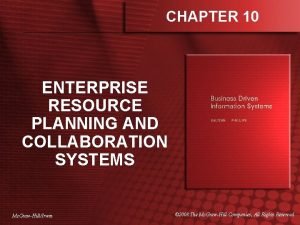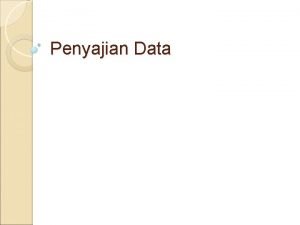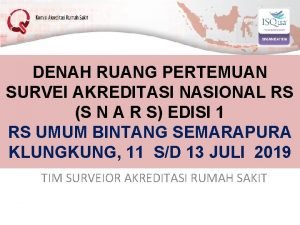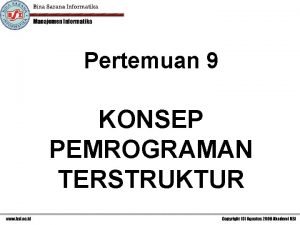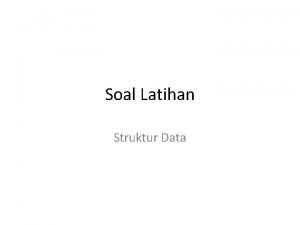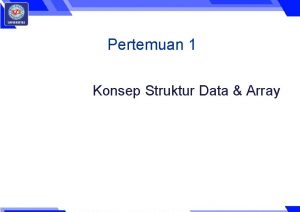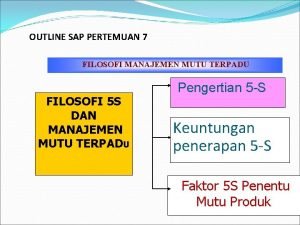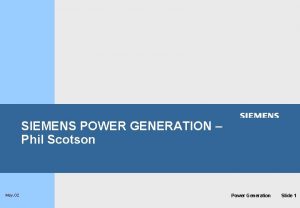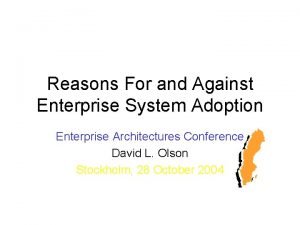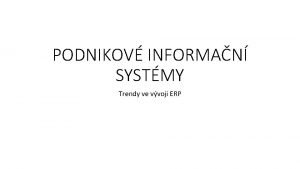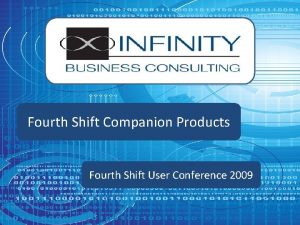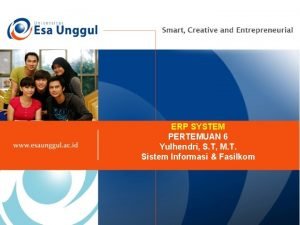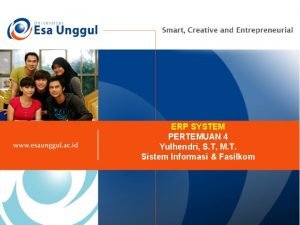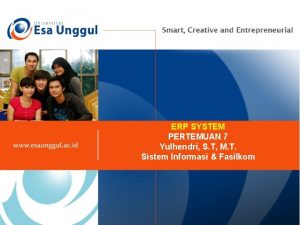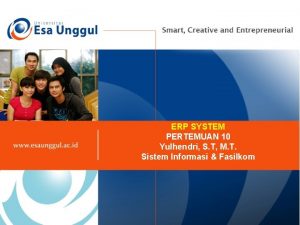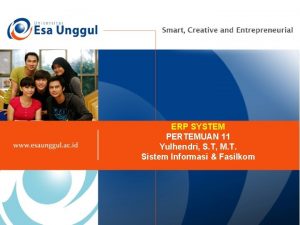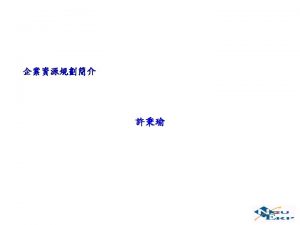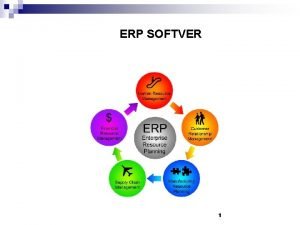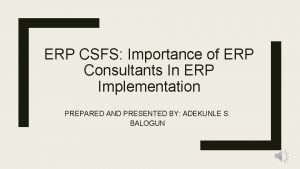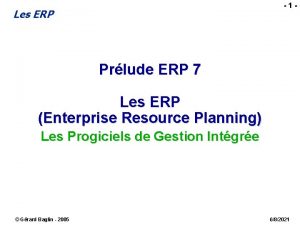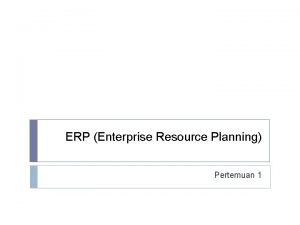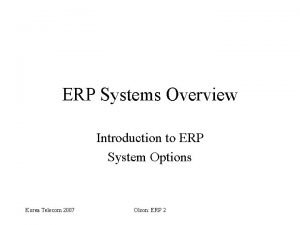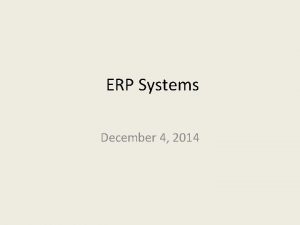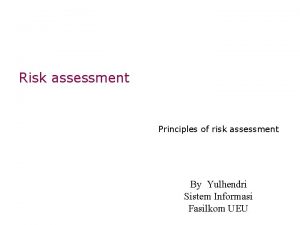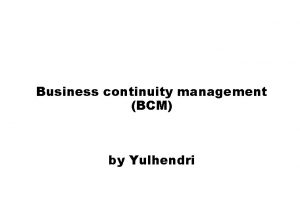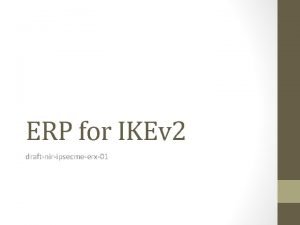ERP SYSTEM PERTEMUAN 9 Yulhendri S T M


























- Slides: 26

ERP SYSTEM PERTEMUAN 9 Yulhendri, S. T, M. T. Sistem Informasi & Fasilkom

KEMAMPUAN AKHIR YANG DIHARAPKAN • Mahasiswa mampu Menguraikan konsep SCM (Supply Chain Management) dan proses integrasinya dengan ERP (Enterprise Resource Planning).

Supply Chain Management Objectives • Supply Chain • SCM Definition • Components of a SCM System • Matching Supply and Demand • Components of a Supply Chain • The Importance of Supply Chain Management

What is a Supply Chain? • A supply chain is the system of organizations, people, activities, information and resources involved in moving a product or service from supplier to customer. • Supply chain activities transform raw materials and components into a finished product that is delivered to the end customer.

Supply Chain Supplier Manufacture r Distributor Retailer Customers

A Supply Chain Example 1… JNJ Kellog V. Highlands Publix Peachtree Ocean Drive Ft. Laud. FL AL P&G TX suppliers State distributors Local stores Super market chains End customer Coke GA Kroger

A Supply Chain Example 2… JNJ Kellog Riyadh Danube Karaj Carrefour Jeddah Makah Western North P&G Eastern suppliers State distributors Local stores Super market chains End customer Coke Center Panda

Supply Chain • Also referred to as the logistics network • Suppliers, manufacturers, warehouses, distribution centers and retail outlets – “facilities” and the • Raw materials • Work-in-process (WIP) inventory • Finished products that flow between the facilities

Supply Chain Processes

The Supply Chain – Another View Plan Source Suppliers Material Costs Make Manufacturers Deliver Warehouses & Distribution Centers Buy Customers Transportation Costs Transportation Manufacturing Costs Inventory Costs

What Is Supply Chain Management (SCM)? Plan Source Make Deliver Buy • A set of approaches used to efficiently integrate § § Suppliers Manufacturers Warehouses Distribution centers • So that the product is produced and distributed § § § In the right quantities To the right locations And at the right time • System-wide costs are minimized and • Service level requirements are satisfied

Basic supply chain management system A basic supply chain management system has five (5) components: 1. Plan • refers to the over-all strategy of the SCM program including the development of SCM metrics to monitor 2. Source • refers to the suppliers who'll provide you with goods and services necessary for you to run your business 3. Make • refers to the execution of processes needed to produce, test, and package your products or services (manufacturing) 4. Deliver • refers to the system for developing a network of warehouses; and getting the products to the customers 5. Buy • refers to the system of receiving orders from customers; invoicing customers and receiving payment from them

Supply Chain Management (SCM) • Supply Chain Management is § § the design and management of processes across organizational boundaries with the goal of matching supply and demand in the most cost effective way. Mission impossible: Matching Supply and Demand

Matching Supply and Demand • Aims to Match Supply and Demand, profitably for products and services SUPPLY SIDE DEMAND SIDE • Achieves: The right Product + + + The right Price Store Quantity + The right + Customer The right Time = Higher Profits

Why so Difficult to Match Supply and Demand? • Why is supply chain management difficult? • Different organizations in the supply chain may have different, conflicting objectives • Manufcturers: long run production, high quality, high productivity, low production cost • Distributors: low inventory, reduced transportation costs, quick replenishment capability • Customers: shorter order lead time, high in-stock inventory, large variety of products, low prices • Supply chains are dynamic - they evolve and change over time

SCM in a Supply Network • Supply Chain Management (SCM) ) is concerned with the management and control of the flows of material, information, and finances in supply chains Cash Products and Services Information THAILAND INDIA N-Tier Suppliers Supply Side MEXICO Logistics TEXAS Distributors OEM Demand Supply US Retailers Demand Side


Supply Chain for Denim Jeans

Supply Chain for Denim Jeans (cont. )

Components of a Supply Chain • External Suppliers– source of raw material • Tier one supplier supplies directly to the processor • Tier two supplier supplies directly to tier one • Tier three supplier supplies directly to tier two • Internal Functions include – processing functions • Processing, purchasing, planning, quality, shipping

Components of a Supply Chain • External Distributors transport finished products to appropriate locations • Logistics managers are responsible for managing the movement of products between locations. Includes; • traffic management – arranging the method of shipment for both incoming and outgoing products or material • distribution management – movement of material from manufacturer to the customer

The Importance of Supply Chain Management • Dealing with uncertain environments – matching supply and demand • U. S Surgical Corporation announced a $22 million loss in 1993 due to “larger than anticipated inventories on the shelves of hospitals” • Hewlett-Packard and Dell found it difficult to obtain important components for its PC’s from Taiwanese suppliers in 1999 due to a massive earthquake

The Importance of Supply Chain Management • Better information sharing among the partners • The growth of technologies such as the Internet enable greater collaboration between supply chain trading partners • If you don’t do it, your competitor will • Availability of SCM technologies on the market • Firms have access to multiple products (e. g. , SAP, Baan, Oracle, JD Edwards) with which to integrate internal processes

Top 25 Supply Chains • The Top 25 supply chains report comes out in Novembers. • The table on the right-hand side is from The Second Annual Supply Chain Top 25 prepared by Kevin Riley and Released in November 2005.

Dell Computer • Classic case in supply chain management. • Established in 1984, Dell experienced supply problems in 1993 and thereupon completely redesigned its supply chain process along the lines of what its founder, Michael Dell, called the “direct” model. • Between 1993 and 1998, Dell's earnings subsequently grew at 65 percent per year.

Dell Computer (con. ) • Dell's supply chain redesign was based on the following elements. • First, Dell sells directly to customers, eliminating the wholesaler and retailer. • Second, Dell also takes advantage of new information technologies in their communications with suppliers who can access Dell's component inventories, production plans, and forecasts in real time and thus keep their production precisely matched to Dell's needs. • Third, Dell maintains absolute minimum inventory levels at every stage of production, averaging 4 days overall
 Scm, crm, and erp are all extended erp components.
Scm, crm, and erp are all extended erp components. Tugas pertemuan 9 metode perancangan program
Tugas pertemuan 9 metode perancangan program Diagram batang
Diagram batang Contoh pendekatan kontribusi
Contoh pendekatan kontribusi Pertemuan multikultural
Pertemuan multikultural Denah ruang pertemuan
Denah ruang pertemuan Pleonasme adalah
Pleonasme adalah Tugas statistika pertemuan 2
Tugas statistika pertemuan 2 Pada pertemuan kali ini kita
Pada pertemuan kali ini kita Tester
Tester Pertemuan 9
Pertemuan 9 Pertemuan awal pkh adalah
Pertemuan awal pkh adalah E miring
E miring Spk latihan pertemuan 6
Spk latihan pertemuan 6 Sel adalah pertemuan antara titik-titik dan titik-titik
Sel adalah pertemuan antara titik-titik dan titik-titik Deklarasi array x adalah double a 2 4 5
Deklarasi array x adalah double a 2 4 5 Diketahui float a 5
Diketahui float a 5 Sell adalah pertemuan antara
Sell adalah pertemuan antara Sukrosa
Sukrosa Logo pertemuan
Logo pertemuan Penawaran elastis uniter terjadi jika
Penawaran elastis uniter terjadi jika Etiket adalah
Etiket adalah Avante erp software
Avante erp software Maritime erp
Maritime erp Erp system dxn
Erp system dxn Erp systém co to je
Erp systém co to je Fourth shift erp
Fourth shift erp
